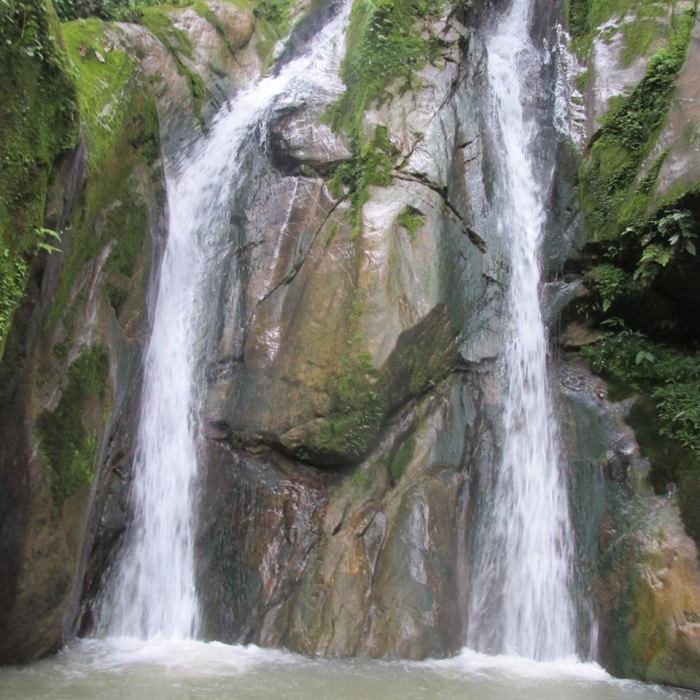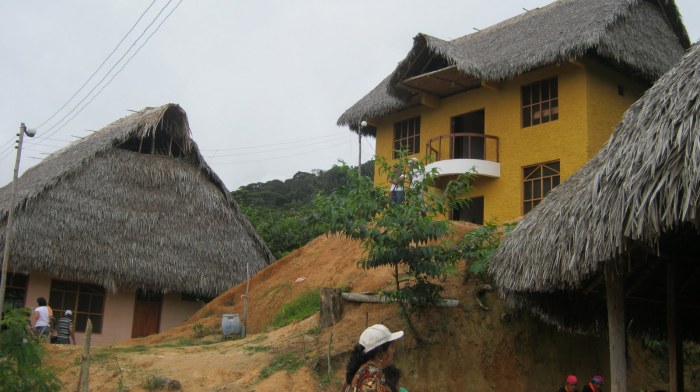Our purpose is to provide travellers with unique experiences while directly benefiting the economic development and political empowerment of local communities.
HISTORY
Lamas, Wayku Native Quarters:
Museums, Castle of Lamas, native community Chiricyacu, overnight stay in an indigenous village, 4 hour hike to 100m Waterfall Toroyacu, indigenous guides who show their passion for the many medicinal plants, birds and insects along the way, camping, cooked food on the open fire, and ending your trip in San Roque de Cumbaza to enjoy the River Cumbaza.
Photo: Thida Leiper
Chanca and Metizo Indians
Lamas town is the capital of the province of Lamas and is located slightly higher than Tarapoto at 1000 feet and is 22 km northwest from the city, Because Lamas is situated slightly higher than the city it has a pleasant and slightly cooler climate.The first level now called ‘Wayku’ was first occupied by the Chanca people (pre-hispanic culture,) who arrived from the South Andes. The Mestizo people lived slightly higher, where the plaza and the centre of Lamas is based. The ‘Castle of Lamas’ (built by an Italian) is now awkwardly standing, in a place which was historically used as a lookout point for invaders.
Today Lamas retains the division between Indians, Chanca and Mestizos, as they celebrate their feast and patron saints separately. The people still fight to maintain their cultural customs to this day, especially so in the lower Chanca, Wayku neighbourhood.
Although Lamas is located in the jungle, the town has the structure of an Andean village, with a mountain town atmosphere, steep streets and terraces, the town reflects the origin of its inhabitants.

Photo: 100% chuen
Native Community Wayku
In the neighbourhood of Wayku the people still retain the Quechua Lamista language. Particularly striking is the lack of windows in their homes which the people believe will prevent the entry of evil spirits. The women wear colorful ribbons in their hair, indicators of marital status and social position.On the perimeter of the main square you will find stores selling crafts, restaurants and you can join in the fun as local musicians preform and the locals dance.
Places to visit in Lamas
Lamas Ethnic Museum - the history and folklore of the Quechua - Lamista culture, the lanta - tipina the first haircut, the making of clothes from native cotton and other vegetable fibers, dyeing, and the dances of the lamas people.
Castle of Lamas -
Impressive building created with 5 levels of natural stone molded by hand. Inside some religious and imperial paintings, craft sales and a small restaurant where you can buy a coffee.
Chapawanki -
30 mins walk, This awesome waterfall is near the village of Urco Pata, surrounded by a lush forest with trees of many species along the way, you can find orchids and ferns and variety of birds , butterflies and insects. The natural landscape offers a distinctive ambiance of the high forest.

Chiricyacu -
located a 30 min drive from the center of Lamas. The women in the village are skilled in the preparation of clay, bowls and cotton crafts called Chumbe weaving very symbolic.


Toroyacu waterfall -
At 1230m San Roque has a waterfall of 100 meters high. Upon arrival you will hear the sound produced by its waters crashing into the pool as if the sky thundered before a heavy rain.
 Photo: 100% chuen
Photo: 100% chuen

Photo: Rodrigo Adriao

Photo: Ezra Stoler
Short walk into the neighborhood of Wayku, visit the Craft Center ‘Waska Waska Warmi Wasi.’ Opportunity to buy artisanal crafts.
Lunch in the town of Lamas
Drive to the village of Chiricyacu.
Learn how to make a basic bowl shape, weave a chumbe (traditional belt) or basket weaving – with the Quechua Lamista Artisans.
Dinner using foods harvested locally.
Overnight stay in the local hostel ‘Valenc
Hike (3 hours) to waterfall ‘ Sunipi Causani’ (Toroyacu.)
Crossing over the jungle by cable car.
Camping and cooked meals on the open fire.
Swim by the waterfall and take in this magnificent sacred site.
Camping by the waterfall.
Time to relax before the hike to San Roque.
(3-hour hike) to the village of San Roque De Cumbaza.
Lunch in the village
End of your adventure
 Photo: 100% chuen
Photo: 100% chuen
Photo: Rodrigo Adriao

Photo: Ezra Stoler
3 DAY TRIPS – LAMAS TO SAN ROQUE – HIKE
Day 1: Lamas
Castle of Lamas.Short walk into the neighborhood of Wayku, visit the Craft Center ‘Waska Waska Warmi Wasi.’ Opportunity to buy artisanal crafts.
Lunch in the town of Lamas
Drive to the village of Chiricyacu.
Learn how to make a basic bowl shape, weave a chumbe (traditional belt) or basket weaving – with the Quechua Lamista Artisans.
Dinner using foods harvested locally.
Overnight stay in the local hostel ‘Valenc
Day 2: Waterfall Toroyacu – Camping
Early start breakfast.Hike (3 hours) to waterfall ‘ Sunipi Causani’ (Toroyacu.)
Crossing over the jungle by cable car.
Camping and cooked meals on the open fire.
Swim by the waterfall and take in this magnificent sacred site.
Camping by the waterfall.
Day 3: San Roque De Cumbaza
Breakfast by the waterfall.Time to relax before the hike to San Roque.
(3-hour hike) to the village of San Roque De Cumbaza.
Lunch in the village
End of your adventure
Includes: Transportation (during the all experience) , tour leader english speaker, food, hosting, local guides , camping equipment.